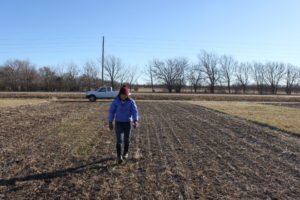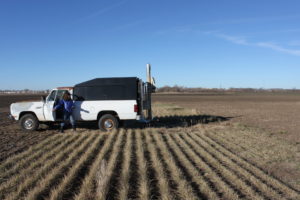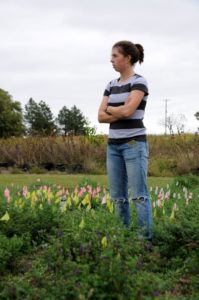Interview with Madeline Dubois
This interview is part of a series which highlights the work of various individuals and organizations within the Kernza® network. Through these interviews, we aim to share and celebrate that there is a large and ever-changing ecosystem that moves Kernza® perennial grain forward. If you would like your organization’s work to be featured in an interview, please email Sophia Skelly. To learn more about the Kernza® network, visit our directory.
Can you introduce yourself and talk about what brought you to The Land Institute?
My name is Madeline Dubois and I am the Ecology Research Technician at The Land Institute. I found out about The Land Institute (TLI) while studying environmental engineering at Northeastern University, where we do co-ops throughout our four-five years. I was looking for a 6-month internship. At the time, I was really interested in water use and I had read that agriculture uses more than 80% of our freshwater supply globally and more than 90% in some parts of the U.S. 
I found TLI online and really wanted to be working on solutions for some of the problems we have with our agriculture system, including but not limited to water supply issues. Then I was looking at the Instagram and they were doing a series called the “Humans of The Land Institute” and everyone had such genuine smiles and their responses were really thoughtful and they seemed really passionate about the projects they were working on.
Can you describe what it means to be an ecology technician? What does that look like?
I conduct all the day-to-day tasks for our experiments. Many of them are centered on reducing non-renewable resource inputs in agriculture, focusing especially on nitrogen. So we’re working on how to develop intercrops where the legume will provide the nitrogen to our perennial grains.

We have lots of experiments that look at different aspects of that legume-grain intercrop system. For example, we have the Nelder Fan, which is a spacing experiment aimed at determining the optimal spacing of Kernza® and alfalfa. We also have the tube garden experiment, which has an alfalfa plant and a Kernza® plant together in a PVC tube. The alfalfa was enriched with an isotope of nitrogen, 15N, so we can track how the nitrogen moves in the system over time – how much ends up in the soil and how much, if any, is taken up by the Kernza®. We also have field-level experiments where Kernza® and alfalfa are planted in rows and we’re looking at how much nitrogen is supplied by the alfalfa. I also take gas measurements, conduct soil testing in the lab, plant and harvest crops…it’s a huge variety.
Can you pick a day this week and walk me through what you worked on?
The other day, I was out doing gas sampling with the Gasmet for about two hours. For that, we’re really interested in the amount of nitrous oxide that’s coming off the fields so we do weekly measurements in the same location to track that over time. We’re also measuring carbon dioxide and methane so we have a picture of what’s happening throughout the season. So, this instrument measures the equilibrium rate of those gasses coming out of the soil, off that field. At the same time, I’ll take soil samples from two centimeters deep and do a wet to dry analysis. So you weigh it when it’s wet, put it in the oven, and then weigh it again when it’s dry to get an idea of the soil moisture at the time that we took the measurement.
I’ve also been working on installing lysimeters, which are instruments that can be used to extract soil pore water. So I’ve been constructing those, which includes cutting PVC pipes, putting stoppers in and gluing on the ceramic cup. For these particular lysimeters, some of them are a half meter deep and some of them are a full meter deep. Essentially, there’s a porous ceramic cup on the end, a meter deep in the soil, and you create a vacuum inside the tube and, over 24 hours, water gets sucked through the porous cup and then we can do testing on that water for different nutrients
Are there any experiments you’re particularly excited about?

The Nelder Fan is pretty exciting! It’s essentially a series of concentric circles of alfalfa and Kernza® plants. And there’s every combination of spacing of one plant relevant to its same species and to the other species. We saw such dramatic differences in the plants. The ones that were further outside the circle were much more robust. They were orders of magnitude larger for stem diameters, number of seed heads, and they were a noticeably different color. Plants that have a yellowish color are normally nitrogen deficient. So it was really cool to actually see all of those differences.
What’s next for the Nelder Fan experiment? Is it ongoing?
Yes, we’re going to track it over several years because the plants will theoretically continue to become larger. Additionally, we’re going to measure the weed biomass next year. That’s something we weren’t looking at before but it could be really important. Your plants could perform the best if they have two feet in-between them but that’s not really realistic to plant in a field if you have to weed regularly. We need to strike a balance of having enough cover but not so much that it’s an issue.
Have you made any recent important discoveries for advancing your work?
The only one I can think of is not recent but it is exciting! Last summer, when I was still an intern, I worked on a soil moisture project. It looks like alfalfa and Kernza® are drawing on soil moisture at different depths so I was exploring that further. The Kernza® was drawing on water at a meter deep, whereas alfalfa is drawing water from up to three meters deep, which means they are likely compatible in terms of water usage. They’re not competing for water sources. So this could mean that they are compatible for both water and nitrogen use.
Do you have a favorite piece of equipment that you use in your job?

Oh my gosh, there are so many good ones! One of them is definitely the geoprobe. We periodically take soil cores, so we can do nutrient analysis on the soil up to a meter deep. So in order to do that we use the geoprobe, which pulls out a core that’s two inches in diameter and then we cut that core into twenty centimeter horizons and we do our analysis on those horizons to get an idea of what the soil looks like at different depths.
I also love the plot combine, which is specifically made for research. It harvests a six-foot wide diameter. It’s really cute, and tall and skinny. It’s such an incredible machine! Whenever I’m riding on one, I’m like: wow, it is currently cutting down the wheat, threshing it, and giving us a bag of seeds, which would take so long to do by hand.
What’s your favorite part about your job?
I love the opportunity to be outside so frequently and also how every single day is different. There is such a variety of tasks and projects and things that we’re looking at so it’s always exciting. I also feel so lucky to work with such great people!
What is your favorite Kernza® product?
I’m a fan of the beer for sure. My mom also makes some really great pull-apart Kernza® rolls.